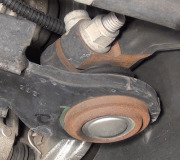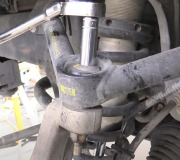I'm going to have you go in a different direction, then, if this doesn't pan out, please start a new question. You don't have to retype everything. Just copy and paste what you already wrote. It's easy to do and I can help if you don't know what I mean.
The reason is unlike on other forums where anyone can jump in and confuse the issue, here this has just become a private conversation between the two of us. As such, none of the other experts will see this question or have a chance to reply. That may not get you the help you need.
The issue I'm referring to is use of the wrong transmission fluid. Especially given the mileage, it has likely been replaced a couple of times. This applies to many brands of car. Chrysler introduced a lockup torque converter in the mid 1970s to increase fuel mileage. That clutch can't be engaged at low speeds because when coming to a stop, it would snub off the engine just as it would with a manual transmission, and you forgot to push the clutch pedal. When that clutch engages, it locks up gradually to avoid creating a thump. It begins with partial lockup at anywhere between 35 to 45 mph, and will be fully engaged with no slippage within another ten to 15 mph.
Besides slowing down, one of the things that causes the clutch to unlock is tapping the brake pedal. That's done to anticipate coming to a stop. That gives us a dandy clue to the shudder it causes when the wrong fluid is used. Drive at a speed where this occurs, then hold the accelerator and road speed steady. Now lightly tap the brake pedal for an instant with your left foot. If the vibration clears up, then resumes a few seconds later, the fluid is the best suspect. The correct fluid has additives that reduce the clutch plates' ability to lock up gradually. When those additives are missing or are the wrong ones, it grabs too hard, then engine torque breaks it free, then the plates try to lock again. That happens so fast that it creates the shudder all mechanics have experienced. If nothing changes when you tap the brake pedal, don't replace the transmission fluid just as a test. We'll have to look somewhere else.
As far as that somewhere else, the first thing to consider is every vibration has to be caused by something that is rotating. Axle shafts never get balanced because they're turning too slowly, and they have such a small diameter that you'll never feel a vibration from them. A different problem can develop with the inner CV joints that causes the steering wheel to oscillate back and forth, but only under the load of moderate to hard acceleration. This is a really tricky one to find, but you already have new half shafts, so we can move on. By the way, the cause of that problem is extremely easy to overlook when the shaft is being rebuilt. New shafts today have come down so much in cost that it doesn't pay to risk getting that problem by buying a rebuilt shaft.
A very badly worn outer CV joint can cause clicking and crunching noises, but speed has little to do with that. You're more likely to hear it in a parking lot, not at higher speeds. Same with rust build-up on the back of the brake rotors. You'll hear that at low speeds and much more when braking.
Tie rod ends and ball joints never cause a vibration on their own, but if badly worn, they can allow a vibration to become noticeable that is caused by something else. Either one can allow a tire to walk toward or away from the center of the car, until the sidewall can't flex any more, then the tread snaps back and starts that all over. That shows up as a choppy pattern on the tread of both tires on that axle, even though only one side has the worn part, but you'll rarely feel it. Tire wear is one of three things we look at when beginning an alignment, but it is the only one that takes time to show up, and it's the one most drivers never notice.
Another elusive cause of a vibration at specific speeds is a broken belt in a tire, but not in the way we normally find them. Every mechanic has run into tires with tumors growing out of the tread, or tread that squirms left and right as you spin the tire. Those are easy to spot by eye. The more elusive broken belt develops so slowly that as the high spot builds, it wears down so you don't see it. In my sad drawing below, the common broken belt is on the left. The one I'm talking about is on the right. As you spin the tire, the tread that contacts the road surface remains smooth and steady but look at the lower right where I put the little red line. The inner groove moves up and down as you spin the tire. Most mechanics who aren't alignment specialists don't know to look for that type of broken belt. This used to be extremely common on Uniroyal tires that came on GM vehicles as original equipment. If you're questioning whether what you find here is causing the vibration, switch the left front and rear tires, then drive the car to see if the sensation has changed. If it hasn't, switch the two right tires front to back and try again.
This isn't an alignment problem either. Besides the choppy wear pattern I described, which affects both tires, look for an off-center steering wheel, and whether the car goes straight when you let go of the steering wheel, or if it drifts to one side. Don't expect any car to go a half mile like that, but you should be able to let go of the steering wheel for a good five seconds before you go into the ditch or oncoming traffic.
Let me know if anything here looks like it could be involved, then we'll decide if I should continue or if it's better to repost your question.
Image (Click to make bigger)
Saturday, January 13th, 2024 AT 7:39 PM



